pilgrims
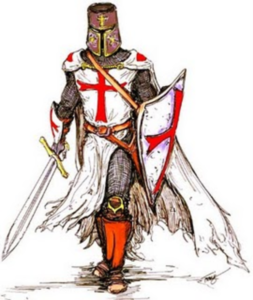 The word knight always makes me think of medieval men in full armor fighting with shields and swords, and maybe that isn’t so far off with the Knights Templar. One thing I didn’t connect to the knights, was Christianity, but maybe I should have. The medieval knights are a little outside my wheelhouse, but I have had an interest in them for a while now, and the Knights Templar are at the top of my list. So, I decided to have a look at exactly what they are, beginning with the Knights Templar.
The word knight always makes me think of medieval men in full armor fighting with shields and swords, and maybe that isn’t so far off with the Knights Templar. One thing I didn’t connect to the knights, was Christianity, but maybe I should have. The medieval knights are a little outside my wheelhouse, but I have had an interest in them for a while now, and the Knights Templar are at the top of my list. So, I decided to have a look at exactly what they are, beginning with the Knights Templar.
After Christian armies captured Jerusalem from Muslim control in 1099 during the Crusades, groups of pilgrims from across Western Europe started visiting the Holy Land. As they traveled, many of them were robbed and killed crossing through Muslim-controlled territories during their journey. A French knight named Hugues de Payens created a military order along with eight relatives and acquaintances, calling it the Poor Fellow-Soldiers of Christ and the Temple of Solomon. Later known simply as the Knights Templar (Knights of the Temple), it was founded in 1118 in Jerusalem, and was a large organization of devout Christians who carried out an important mission: to protect European travelers visiting sites in the Holy Land. The first headquarters of the Knights Templar was located on the site of the Temple of Solomon, and it was to this temple that the organization was dedicated and where it got its name.
Initially, the Knights Templar faced criticism from some religious leaders. There are always those who think the church and any kind of government or military group should not mix, but in 1129, the group received the formal endorsement of the Catholic Church and support from Bernard of Clairvaux, a prominent French abbot. Bernard authored “In Praise of the New Knighthood,” a text that supported the Knights Templar and bolstered their growth. In 1139, Pope Innocent II issued a Papal Bull that allowed the Knights Templar special rights. Among them, the Templars were exempt from paying taxes, permitted to build their own oratories and were held to no one’s authority except the Pope’s.
The Knights Templar quickly set up a network of banks and gained enormous financial influence, with an ability to quickly fund their work. Their banking system allowed religious pilgrims to deposit assets in their home countries and withdraw funds in the Holy Land. The order became known for its austere code of conduct (which included no pointy shoes and no kissing their mothers, rules outlined in “The Rule of the Templars”) and signature style of dress, which featured a white habit emblazoned with a simple red cross. Members swore an oath of poverty, chastity and obedience. They weren’t allowed to drink, gamble or swear. Prayer was essential to their daily life, and the Templars expressed particular adoration for the Virgin Mary.
New chapters of the Knights Templar were established throughout Western Europe as the group grew in size and status. At the height of their influence, the Templars had a sizable fleet of ships, and they owned the Mediterranean island of Cyprus. They served as a primary bank and lending institution to European monarchs and nobles. Though its original purpose was to protect Christiam pilgrims from danger, the Knights Templar later expanded its duties. They became defenders of the Crusader states in the Holy Land and were known as brave, highly skilled warriors. The group developed a reputation as fierce fighters during the Crusades. They were driven by religious zeal and forbidden from retreating unless significantly outnumbered, and I doubt if they would even then. The Templars built numerous castles. They fought, and often won, battles against Islamic armies. Their fearless style of fighting became a model for other military orders. They were quite the group.
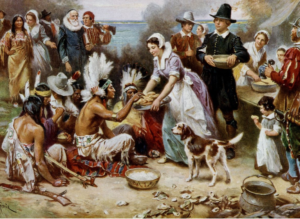 The past almost two years have been tough for everyone. Many of us have had to forgo this holiday or that holiday, because on or more family members have contracted Covid-19, and had to be quarantined. Nevertheless, more and more people are surviving Covid, and that is definitely something to be thankful for. In fact, as I contemplate Thanksgiving I find that I feel the need to look for things to be thankful for, rather than complaining about how hard things have been. That reminds me of the first Thanksgiving.
The past almost two years have been tough for everyone. Many of us have had to forgo this holiday or that holiday, because on or more family members have contracted Covid-19, and had to be quarantined. Nevertheless, more and more people are surviving Covid, and that is definitely something to be thankful for. In fact, as I contemplate Thanksgiving I find that I feel the need to look for things to be thankful for, rather than complaining about how hard things have been. That reminds me of the first Thanksgiving.
Most of us picture a big party were the new neighbors, the Pilgrims and the Wampanoag Indian Tribe, came together to celebrate newfound friendships, but that wasn’t it at all. Many in the Wampanoag tribe, as well as the entire Patuxet Tribe, had died of smallpox. To make matters worse, the Pilgrims were in danger of starving to death.  They really didn’t know much about farming, and between the smallpox, the winter cold, and lack of food, the Pilgrims were in a lot of trouble. With the help of the Wampanoag Tribe, the things they had to be thankful for, were many and they really were.
They really didn’t know much about farming, and between the smallpox, the winter cold, and lack of food, the Pilgrims were in a lot of trouble. With the help of the Wampanoag Tribe, the things they had to be thankful for, were many and they really were.
This past year reminds me quite a bit of the situation the Pilgrims and the Indians were in when they pulled together, helped each other, and in the end came through with much to celebrate and much to be thankful for. We have a long way to go, because much is broken right now, but the people of this nation are starting to fight for the the freedoms we have always known and loved, and we are thankful for every victory we see, and they are coming each day. Like the Pilgrims and the Indians, we have a long way to go, and many battles along the way, but we are a persevering people, and we will be great again. I am so thankful for all the people who are  willing to step in and fight for this country, for life, liberty, and the pursuit of happiness. With people like this and above all, our awesome God leading the battle, we can’t lose.
willing to step in and fight for this country, for life, liberty, and the pursuit of happiness. With people like this and above all, our awesome God leading the battle, we can’t lose.
We have come through the times of illness, loss, and trial. Now we, as a nation, need to begin to pick ourselves up by our boot straps and prove to ourselves exactly what we are made of. I have no doubt in my mind that we can do this, and by Thanksgiving of 2022, we will be totally amazed at who we are, how far we have come, and we will have so many more things to be thankful for. Happy Thanksgiving everyone!! Have a great holiday!!
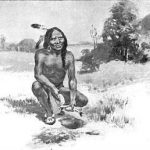 As Thanksgiving approaches, I’ve been thinking about the Wampanoag Tribe, who helped the Pilgrims survive that first winter in the new world. It was a tough winter, and both the Wampanoag Tribe and the Pilgrims lost a lot of people. Many in the Wampanoag tribe, as well as the entire Patuxet Tribe, had died of smallpox. In fact, the Pilgrims might not have made it in this new country at all if the Wampanoag Tribe hadn’t helped them. The Wampanoag had fed the colonists and saved their lives when their colony was failing in the harsh winter of 1620-1621. The name Wampanoag means People of the First Light…isn’t that beautiful? The two peoples shared their knowledge. The Wampanoag Tribe taught the Pilgrims to hunt and fish, and the Pilgrims taught the Wampanoag Tribe to plant corn and beans.
As Thanksgiving approaches, I’ve been thinking about the Wampanoag Tribe, who helped the Pilgrims survive that first winter in the new world. It was a tough winter, and both the Wampanoag Tribe and the Pilgrims lost a lot of people. Many in the Wampanoag tribe, as well as the entire Patuxet Tribe, had died of smallpox. In fact, the Pilgrims might not have made it in this new country at all if the Wampanoag Tribe hadn’t helped them. The Wampanoag had fed the colonists and saved their lives when their colony was failing in the harsh winter of 1620-1621. The name Wampanoag means People of the First Light…isn’t that beautiful? The two peoples shared their knowledge. The Wampanoag Tribe taught the Pilgrims to hunt and fish, and the Pilgrims taught the Wampanoag Tribe to plant corn and beans.
A man named Squanto, who was born about 1580 near Plymouth, Massachusetts, also known as Tisquantum, is best remembered for serving as an interpreter and guide for the Pilgrim settlers at Plymouth in the 1620s. The details about how Squanto got to Europe and back have been disputed by historians. He was a Patuxet Indian born in present-day Massachusetts, who is believed to have been captured as a young man along the Maine coast in 1605 by Captain George Weymouth, who had been commissioned by Plymouth Company owner Sir Ferdinando Gorges to explore the coast of Maine and Massachusetts, and reportedly captured Squanto, along with four Penobscots, because he thought his financial backers in Britain might want to see some Indians. Weymouth brought Squanto and the other Indians to England, where Squanto lived with Ferdinando Gorges, who taught him English and hired him to be an interpreter and guide. Now fluent in English, Squanto returned to his homeland in 1614 with English explorer John Smith, possibly acting as a guide, but was captured again by another British explorer, Thomas Hunt, and sold into slavery in Spain. Squanto escaped, lived with monks for a few years, and eventually returned to North America in 1619, only to find his entire Patuxet tribe dead from smallpox. He went to live with the nearby Wampanoags. Squanto’s life was truly not easy, but he still wanted to help others. Nevertheless, Squanto was the first person the Pilgrims met. He spoke to them in 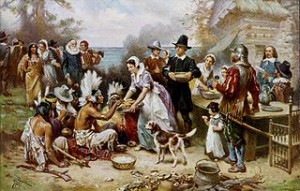 English and acted as an interpreter and guide to the Pilgrim settlers at Plymouth during their first winter in the New World. Squanto was born in about 1580 near Plymouth, Massachusetts.
English and acted as an interpreter and guide to the Pilgrim settlers at Plymouth during their first winter in the New World. Squanto was born in about 1580 near Plymouth, Massachusetts.
Squanto’s assistance in connecting the Pilgrims with the Wampanoag Tribe was vital for the preservation of the Pilgrims. There were many reasons to be Thankful on that first Thanksgiving. They had survived the winter, and smallpox. They weren’t starving or dying of starvation. They had new friends, and they had learned new skills. It is believed that the first Thanksgiving is generally believed to have occurred between September 21 and November 9, 1621.
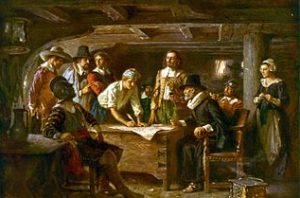 The September 6, 1620 trip to the new world, in which 102 passengers, who had been dubbed Pilgrims by William Bradford, one of the passengers who would become the first governor of Plymouth Colony, was a crowded, grueling trip on the Mayflower to a new life in the New World. The trip was filled with hardship, and sometimes even loss. Nevertheless, the pilgrims knew it had to be taken. The situation actually began in 1606, when a group of reform-minded Puritans in Nottinghamshire, England, founded their own church, that was separate from the state-sanctioned Church of England. This was truly the reason why “Freedom of Religion” is such an important part of our constitution. Many people dispute that fact that our nation was formed on religious principles, but it was, from the very core of the move here.
The September 6, 1620 trip to the new world, in which 102 passengers, who had been dubbed Pilgrims by William Bradford, one of the passengers who would become the first governor of Plymouth Colony, was a crowded, grueling trip on the Mayflower to a new life in the New World. The trip was filled with hardship, and sometimes even loss. Nevertheless, the pilgrims knew it had to be taken. The situation actually began in 1606, when a group of reform-minded Puritans in Nottinghamshire, England, founded their own church, that was separate from the state-sanctioned Church of England. This was truly the reason why “Freedom of Religion” is such an important part of our constitution. Many people dispute that fact that our nation was formed on religious principles, but it was, from the very core of the move here.
On November 11, 1620, the Mayflower anchored at what is now Provincetown Harbor, Cape Cod. Of course, it was mandatory that they scout out the new land to make sure it 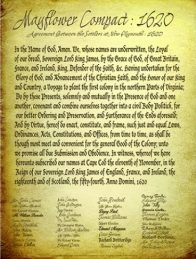 was safe before bringing the women and children there. Before going ashore, 41 male passengers…heads of families, single men and three male servants…signed the famous Mayflower Compact, agreeing to submit to a government chosen by common consent and to obey all laws made for the good of the colony. Over the next month, several small scouting groups were sent ashore to collect firewood and scout out a good place to build a settlement.
was safe before bringing the women and children there. Before going ashore, 41 male passengers…heads of families, single men and three male servants…signed the famous Mayflower Compact, agreeing to submit to a government chosen by common consent and to obey all laws made for the good of the colony. Over the next month, several small scouting groups were sent ashore to collect firewood and scout out a good place to build a settlement.
Around December 10, one of these groups found a harbor they liked on the western side of Cape Cod Bay. They returned to the Mayflower to tell the other passengers, but bad weather prevented them from docking until December 18. After exploring the region, the settlers chose a cleared area previously occupied by members of a local Native American tribe, the Wampanoag. The travel weary pilgrims finally prepared to begin their new settlement, Plymouth Colony. The Wampanoag tribe had abandoned the village several years earlier, after an outbreak of European disease. That winter of 1620-1621 was brutal, as the Pilgrims struggled to build their settlement, find food and ward off sickness. They were less than highly successful, because by spring, 50 of the original 102 Mayflower passengers were dead. The remaining settlers made contact with returning  members of the Wampanoag tribe, and in March they signed a peace treaty with a tribal chief, Massasoit. Aided by the Wampanoag, especially the English-speaking Squanto, the Pilgrims were able to plant crops…especially corn and beans…that were vital to their survival. The Mayflower and its crew left Plymouth to return to England on April 5, 1621.
members of the Wampanoag tribe, and in March they signed a peace treaty with a tribal chief, Massasoit. Aided by the Wampanoag, especially the English-speaking Squanto, the Pilgrims were able to plant crops…especially corn and beans…that were vital to their survival. The Mayflower and its crew left Plymouth to return to England on April 5, 1621.
Over the next several decades, more and more settlers made the trip across the Atlantic to Plymouth, which gradually grew into a prosperous shipbuilding and fishing center. In 1691, Plymouth was incorporated into the new Massachusetts Bay Association, ending its history as an independent colony. And the rest, as they say, is history.
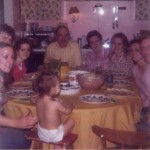 The first Thanksgiving in the fall of 1621 and was shared between the Pilgrims and Indians, was a day complete with new foods to try. The purpose was to spend time together, getting to know each other. I have often wondered if some of those present were ancestors of mine. I have not come across anything in my family’s past that could prove the presence of my family at that first Thanksgiving, but I would not be surprised.
The first Thanksgiving in the fall of 1621 and was shared between the Pilgrims and Indians, was a day complete with new foods to try. The purpose was to spend time together, getting to know each other. I have often wondered if some of those present were ancestors of mine. I have not come across anything in my family’s past that could prove the presence of my family at that first Thanksgiving, but I would not be surprised.
Many of those early traditions are still being carried on today. The big meal, with foods we don’t eat every day. The gathering of friends and family and the celebration of those relationships. We find ourselves reminiscing about the past, and missing the loved ones who are no longer with us, but we also find reasons to be thankful for the things we have and the people who are still in our lives. So often during our day to day lives, we can find ourselves dragged down by the mundane details of daily living, and the stresses of deadlines and daily obligations. We forget the blessings we have.
For that reason, it is important to take the time once in a while to look back on the year and really see all the good things we have. The difference between those mundane details and stresses in life, and blessings is just a matter of perspective. When we look at the memories and abilities that an aging parent has lost, we feel sad, but if we look at what they have left instead, we can see that it is a blessing to still have them in our lives, and that what they have left is a blessing too.
Today, I am thankful for the people in my life. I am thankful for the time I had with those loved ones who are in my past, and soon in my future, like my dad, grandparents, aunts, uncles, cousins, and nieces who have gone home to Heaven. Your lives were a blessing to me and while I miss you right now, I look forward to the time when I will see you again. I am thankful for those loved ones in my present. The people who support me when I am feeling down, and help me in the obligations I have in my life. I am thankful for the loved ones who will come into my life in the future. Your lives will bring me new joy and blessing. I am thankful for friends, past, present, and future who have and will bring kindness and friendship into my life. I am thankful for my job and a boss who goes above and beyond the expected every day to allow me to do the things I need to do. And most of all, I am thankful for my God, who saw that I was lost, and even though I didn’t earn or deserve any kindness, He sent His only begotten son, Jesus, to die for me, to pay for my sins, and through the grace and mercy of my Father, He redeemed my life. He brought me back from the brink of Hell, and gave me the best He has to give…eternity in Heaven with Him.

